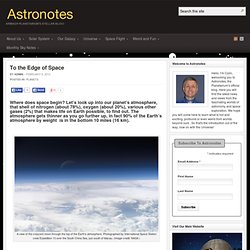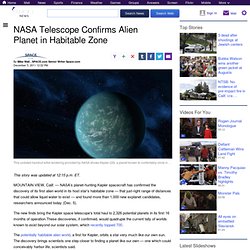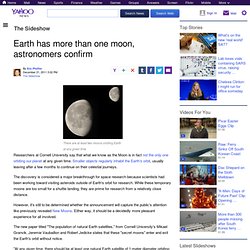

All about Earth's Atmosphere. Where does space begin?

Let’s look up into our planet’s atmosphere, that shell of nitrogen (about 78%), oxygen (about 20%), various other gases (2%) that makes life on Earth possible, to find out. Things You Do Not Know About Outer Space. Life's Little Mysteries - A Daily Investigation of the World Around You. The Planetary Society. Heavy Boots. Editorial note: I received this as an email from a friend who got it from a friend who ...

I do not know who the original author is, but I do believe this to be true. Who could possibly make it up? Heavy Boots About 6-7 years ago, I was in a philosophy class at the University of Wisconsin, Madison (good science/engineering school) and the teaching assistant was explaining Descartes. He was trying to show how things don't always happen the way we think they will and explained that, while a pen always falls when you drop it on Earth, it would just float away if you let go of it on the Moon. My jaw dropped a little. "No it wouldn't. " the TA explained calmly, "because you're too far away from the Earth's gravity. " I countered, "why didn't they float away? " "Because they were wearing heavy boots. " he responded, as if this made perfect sense (remember, this is a Philosophy TA who's had plenty of logic classes).
As we left the room, my friend Mark was raging. 1. 2. 13. 25. Stellarium. Have We Found The Universe That Existed Before The Big Bang? Is the Universe a Holographic Reality? The Universe as a Hologram by Michael Talbot Does Objective Reality Exist, or is the Universe a Phantasm?

In 1982 a remarkable event took place. At the University of Paris a research team led by physicist Alain Aspect performed what may turn out to be one of the most important experiments of the 20th century. You did not hear about it on the evening news. In fact, unless you are in the habit of reading scientific journals you probably have never even heard Aspect's name, though there are some who believe his discovery may change the face of science. Aspect and his team discovered that under certain circumstances subatomic particles such as electrons are able to instantaneously communicate with each other regardless of the distance separating them. University of London physicist David Bohm, for example, believes Aspect's findings imply that objective reality does not exist, that despite its apparent solidity the universe is at heart a phantasm, a gigantic and splendidly detailed hologram.
ASTR 1230, Whittle [Fall 2009]. Lecture Notes. Bitesize Astronomy. Supernova 1987A: The Three Ring Circus Week of March 6, 2000 Last week's Snack talked about why the star that was to become Supernova 1987a (what astronomers call the precursor) exploded.

I concentrated on the core of the star, because for supernovae that's where the action is. I mentioned the outer layers a few times because they play their role in the explosion too: they provide the pressure for the core so it can fuse elements, and in the end it's the ejection of those outer layers that creates the supernova event. I didn't talk much about what those outer layers are doing while the core is going through its evolutionary gyrations.
Again, my apologies. Once upon a time, say a million years or so ago, there was a star that would later be known as Sanduleak -69 202 (named after the man who catalogued stars in that region, and appended with its rough coordinates). As helium piles up in the core, it gets very hot. Nothing last forever, especially a star. That was in 1990. The Astronomy Cafe : Dr. Sten Odenwald - A resource for learning about astronomy. NASA Telescope Confirms Alien Planet in Habitable Zone. This story was updated at 12:15 p.m.

ET. MOUNTAIN VIEW, Calif. — NASA's planet-hunting Kepler spacecraft has confirmed the discovery of its first alien world in its host star's habitable zone — that just-right range of distances that could allow liquid water to exist — and found more than 1,000 new explanet candidates, researchers announced today (Dec. 5). The new finds bring the Kepler space telescope's total haul to 2,326 potential planets in its first 16 months of operation.These discoveries, if confirmed, would quadruple the current tally of worlds known to exist beyond our solar system, which recently topped 700. The potentially habitable alien world, a first for Kepler, orbits a star very much like our own sun. The discovery brings scientists one step closer to finding a planet like our own — one which could conceivably harbor life, scientists said.
Earth has more than one moon, astronomers confirm. There are at least two moons orbiting Earth at any given time Researchers at Cornell University say that what we know as the Moon is in fact not the only one orbiting our planet at any given time.

Smaller objects regularly inhabit the Earth's orbit, usually leaving after a few months to continue on their celestial journeys. The discovery is considered a major breakthrough for space research because scientists had been working toward visiting asteroids outside of Earth's orbit for research. Tonight. Module E : Space Science : Astronomy Dictionary.